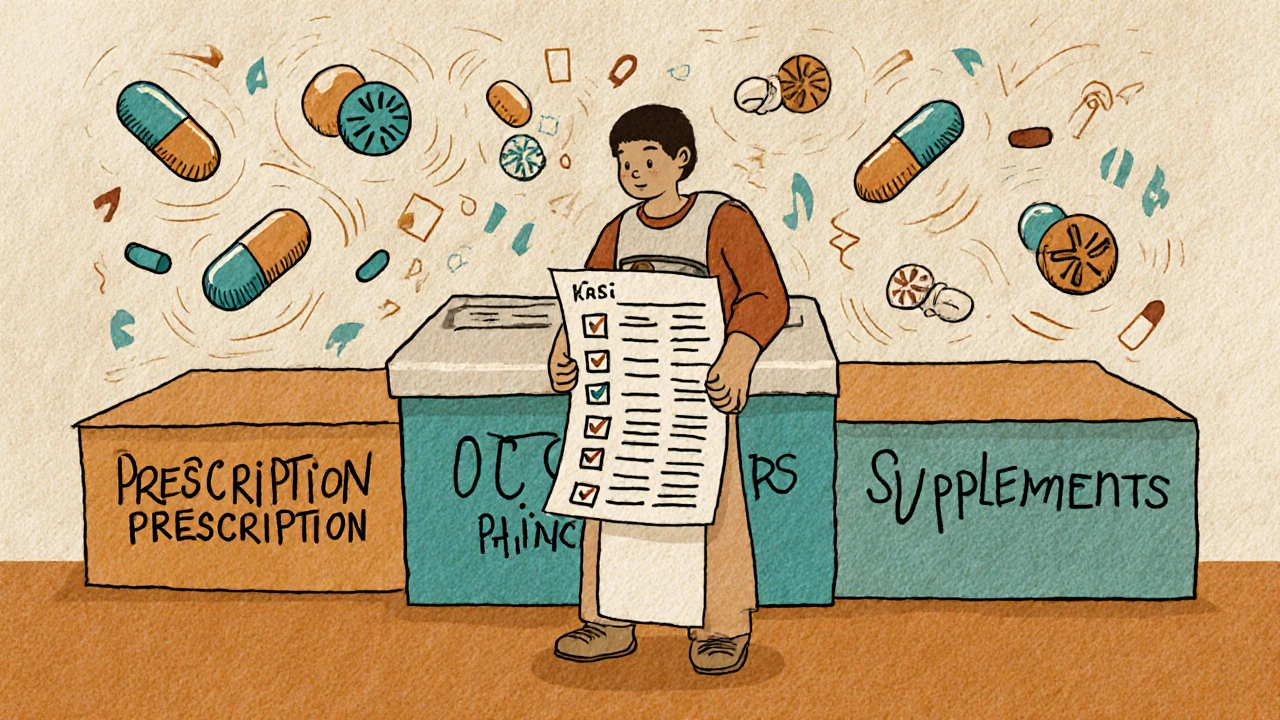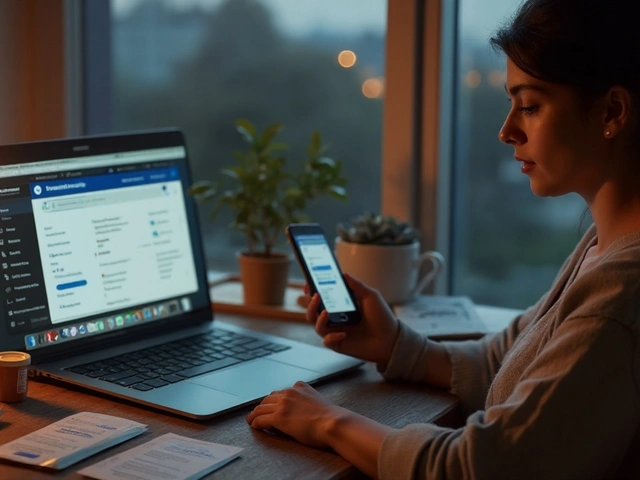Keeping track of your medications is harder than it should be. You fill a prescription at one pharmacy, pick up an over-the-counter painkiller at another, and grab a supplement at the grocery store. Then you visit a new doctor or get admitted to the hospital - and suddenly, no one knows what you’re really taking. That’s where personal health records come in. They’re not just digital files. They’re lifelines that stitch together your entire medication history across every pharmacy, clinic, and corner store where you’ve ever picked up a pill.
Why your meds don’t stay in one place
Most people don’t realize how scattered their medication data is. If you use three different pharmacies - one for your blood pressure pills, another for your diabetes meds, and a third for your weekly OTC supplements - each one keeps its own record. Your doctor’s system might only see what’s been prescribed through their network. That leaves big gaps. In Australia, the My Health Record system pulls data from over 7,800 community pharmacies, but even then, only 57% of pharmacists consistently update it. Why? Because many still rely on manual entry, and it’s slow. A 2022 survey found pharmacists spend an average of 8.3 minutes per patient just fixing errors in patient-entered data.And it’s not just prescriptions. Over-the-counter drugs like ibuprofen, melatonin, or fish oil? Only 37% of personal health records capture those. But those can interact dangerously with your prescription meds. One study showed 53% of patients have medication discrepancies when admitted to hospital - and half of all medication errors happen during care transitions. That’s not a glitch. It’s a systemic blind spot.
How personal health records actually work
A personal health record (PHR) is your personal dashboard for health data. Unlike electronic health records (EHRs) that belong to hospitals or clinics, PHRs are controlled by you. You decide who sees what. In Australia, My Health Record is the national system. In the U.S., Apple Health Records and Surescripts are the most widely used. These systems pull data from three main sources:- Pharmacy benefit manager (PBM) claims - covering 92% of insured prescriptions
- Direct pharmacy feeds - including cash purchases
- What you manually enter - supplements, OTC drugs, or meds from non-participating pharmacies
Behind the scenes, systems like Surescripts use a Master Patient Index that matches you across pharmacies using 12 data points - your name, date of birth, address, even your phone number. It’s 99.2% accurate. But accuracy only matters if the data gets in. And that’s the problem.

The gap between data and reality
Just because a system has your prescription history doesn’t mean it knows what you actually take. Refills don’t equal consumption. You might skip doses. You might stop a medication because it made you dizzy. You might forget to tell your pharmacist you started taking turmeric for inflammation. A Duke University study of 12,000 patient-entered records found 61% had dosage errors. One patient listed “aspirin 81mg daily” - but wrote “810mg.” That’s a tenfold overdose risk.And then there’s timing. Only 41% of PHRs show same-day pharmacy transactions. So if you pick up your new antibiotic on Tuesday, your GP might not see it until Thursday - or not at all if the pharmacy hasn’t synced. That delay can lead to dangerous overlaps. Imagine being prescribed a blood thinner by your cardiologist while your primary care doctor still thinks you’re on the old one. That’s not hypothetical. It’s happened.
Who’s winning - and who’s falling behind
Not all PHR systems are built the same. Apple Health Records is easy to use. It’s on your iPhone. It automatically pulls in prescriptions from pharmacies that connect to Apple. But it only captures 68% of your full medication history. Surescripts, used by hospitals and large pharmacy chains, gets 92%. Why? Because it’s tied directly to pharmacy dispensing systems and insurance claims. But it’s not consumer-friendly. You can’t log in and add your vitamins yourself.In Australia, My Health Record has near-universal coverage - 93% of the population is enrolled. It’s mandatory for pharmacies to send dispensing data. But here’s the catch: only 57% of pharmacists actually do it regularly. Why? Because it interrupts their workflow. The system doesn’t always integrate smoothly with their existing software. Smaller pharmacies using older systems often can’t connect at all. A 2022 survey found implementation costs for new PHR-compatible software average $12,500 per pharmacy. That’s a barrier.

What you can do right now
You don’t have to wait for the system to fix itself. Here’s how to take control:- Use your national system - If you’re in Australia, log into My Health Record. Check your medication list. If something’s missing, add it manually. Don’t assume it’s there.
- Keep your own list - Write down every medication, supplement, and OTC drug you take. Include the dose, how often, and why. Update it every time you change something.
- Bring it to every appointment - Even if your doctor says they can see your records, hand them your list. Say, “This is what I’m actually taking.”
- Ask pharmacies to update your PHR - When you pick up a new prescription, ask: “Will this go into My Health Record?” If they say no, ask why. Push for it.
- Check your records monthly - Look for duplicates, outdated meds, or missing items. If you see an error, report it immediately.
At the University of Pittsburgh, patients who regularly updated their PHRs were 82% more confident managing their meds. But only 44% did it consistently. That’s the gap between potential and reality.
The future is here - if you use it
The rules are changing. In the U.S., the CMS Interoperability and Patient Access Rule (effective July 2024) will force pharmacy benefit managers to share 45 days of medication history with patient consent. That’s a big step. In Australia, My Health Record is already doing it. And new tools like Surescripts’ Clinical Direct Messaging let pharmacists send updates directly to your doctor’s inbox - cutting down phone tag by a third.But technology alone won’t fix this. The real breakthrough comes when you become an active participant. You’re not just a patient. You’re the coordinator of your own care. Your PHR isn’t a passive archive. It’s a living document - and it only works if you keep it current.
Every time you update your list, you reduce the chance of a dangerous interaction. Every time you correct a mistake, you protect yourself. And every time you ask a pharmacist to update your record, you help fix the system for everyone else.
Medication errors aren’t inevitable. They’re a failure of coordination. Your personal health record is the tool that can fix that - if you use it.
Can I add over-the-counter medications to My Health Record?
Yes. My Health Record lets you manually enter OTC drugs, supplements, and vitamins. Go to the Medications section, click "Add Medication," and type in the name, dose, and reason. Even if the pharmacy doesn’t report it, you can still add it yourself. This is critical - many dangerous interactions happen with non-prescription items.
Why doesn’t my PHR show all my prescriptions?
Not all pharmacies are connected to the national system. Smaller or rural pharmacies may use outdated software that doesn’t sync. Also, cash purchases - especially at independent pharmacies - often aren’t reported. Some systems only keep data for 12-18 months, so older prescriptions may disappear. Always double-check and add what’s missing.
Is my medication data secure in My Health Record?
Yes. My Health Record uses AES-256 encryption and follows strict Australian privacy laws. You control who can see your data. You can set access codes for specific health providers or block access entirely. In 2022, the Office of the National Coordinator found 98% of certified PHRs met national cybersecurity standards. But your data is only as safe as your access code - never share it.
Can my doctor see my PHR without me knowing?
No. In Australia, health providers can only access your My Health Record if you’ve given them permission. You’ll get a notification every time someone views your record. You can also review access logs and remove permission at any time. This control is built into the system to protect your privacy.
What if I don’t want to use a digital health record?
You’re not required to use it. But if you don’t, your medication history will stay scattered across pharmacies, doctors, and your own memory. That increases your risk of dangerous interactions, duplicate prescriptions, or missed alerts. If you prefer paper, keep a printed list and update it every time your meds change. Bring it to every appointment. It’s not as convenient, but it still saves lives.
How often should I update my personal health record?
Update it every time you start, stop, or change a medication - even if it’s just a new bottle of painkillers. Don’t wait for your next doctor’s visit. Monthly checks are ideal. If you’re managing multiple chronic conditions, weekly updates are better. The more current your record, the safer you are.





